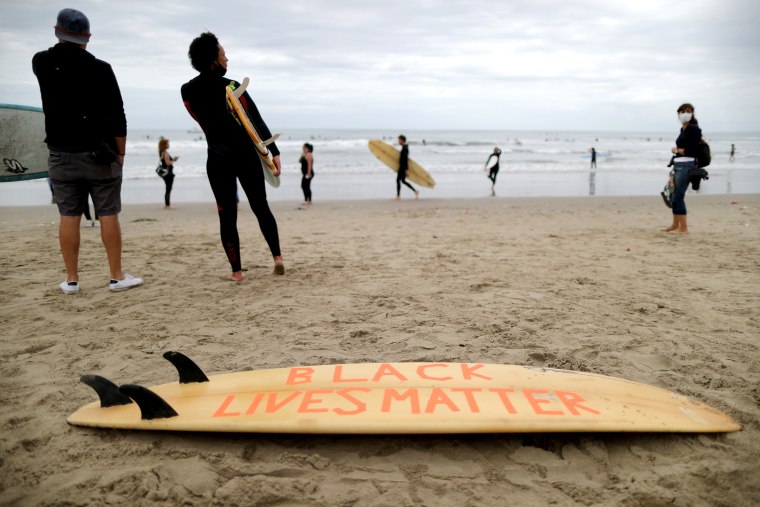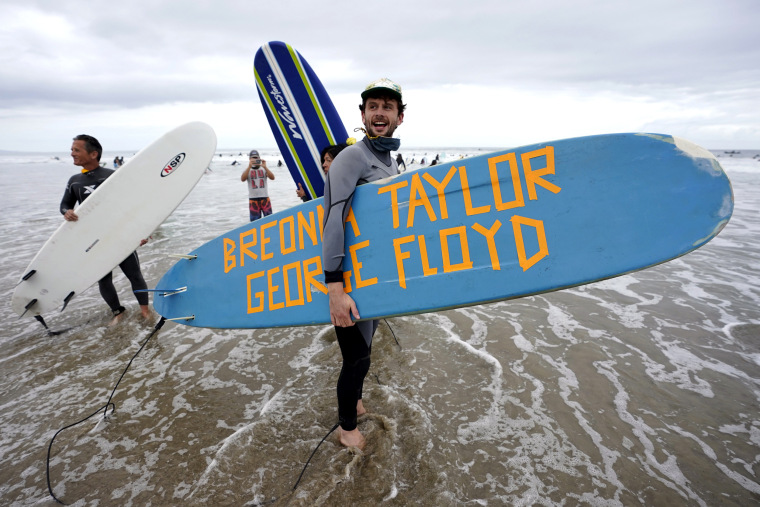
By Dennis Romero – “Behind the aloha vibe was the other vibe — a locals-only, whites-only vibe,” said Sharon Schaffer, the first African American female pro in the U.S.
In surfing, “there was always the good, aloha vibe,” she said recently, “but behind the aloha vibe was the other vibe — a locals-only, whites-only vibe.”
“I shrugged it off,” said Schaffer, of Los Angeles and celebrated as U.S. surfing’s first African American female professional. “But I don’t think I would shrug that off so easily today.”
U.S. surfing, still viewed as largely white and advantaged, may be undergoing a new awakening following the death of George Floyd. The sport that helped popularize the graphic T-shirt, birthed skateboarding and gave the world a name for loafing online is, like other American subcultures, confronting a scourge of racism that has thrived within its own ranks.
On June 5, Schaffer was received with loud applause as demonstrators seeking justice for Floyd, who died May 25 as a Minneapolis police officer held a knee to his neck, gathered on the beach in Santa Monica for a “paddle out” in his honor.
The paddle out is a Hawaiian ritual to honor the dead. It includes venturing beyond the surf line, forming a circle of people on their boards, splashing water and tossing flowers into the sea.
“We have a right to exist on this Earth,” Schaffer told the crowd of people kneeling around her, some with surfboards in hand, according to multiple videos of the event. “We have a right to be in the water.”
Paddle outs for Floyd have also taken place at New York City’s Rockaway Beach and in Australia; Dakar, Senegal; and Galveston, Texas. A demonstration was held on the sand in Biarritz, France.
A paddle out was held Monday at Windansea, the San Diego setting of Tom Wolfe’s 1968 book “The Pump House Gang,” in which young surfers rebel against their well-heeled coastal community, and one character even travels to Los Angeles in 1965 to view the Watts riots as entertainment.
There were paddle outs in the California cities of Huntington Beach and Encinitas, where just weeks earlier conservative demonstrators had called for businesses to reopen amid coronavirus stay-at-home orders.
Surfers wearing Make America Great Again caps were supplanted by those tossing flowers into the sea and proclaiming Black Lives Matter. They prompted some longtime scholars of a sport with a racist past to conclude that it has turned a corner.

“I do think this reflects a cultural shift,” Jess Ponting, founder and director of San Diego State University’s Center for Surf Research, said by email. “Perhaps it simply mirrors the cultural shift taking place in the broader public, but in a very white sport skewed by the racial demographics of who lives close to America’s coasts, I find it very encouraging.”
‘This exclusive club for white people’
Three weeks of protests over Floyd’s death have been a time of atonement for many white Americans. Surfing has a lot to atone for.
The sport in a rapidly diversifying U.S. is still seen as predominantly white despite its origins in Polynesia. Historian Isaiah Helekunihi Walker of Brigham Young University-Hawaii said the state’s colonizers and their descendants tried to make surfing their own.
“The Outrigger Club in Waikiki in 1911 was a way of making this exclusive club for white people,” he said. “It was also an attempt to appropriate surfing as a white sport, and in America it was kind of successful.”
Full coverage of George Floyd’s death and protests around the country
It remained a largely white sport on the mainland after proselytizers Duke Kahanamoku and George Freeth spread it to California and Australia in the early 1900s.
In the 1940s, Southern California produced Nick Gabaldón, a Santa Monica resident of Black and Mexican heritage who surfed at the foot of Bay Street, a beach now home to a plaque marking his pioneering spirit.
Historian Alison Rose Jefferson has been at the forefront of an effort to get the National Register of Historic Places to recognize the spot, the site of the June 5 paddle out, as the Bay Street Beach Historic District.

Black people who tried to establish beach clubs and buy property along the Los Angeles County coast were thwarted by racist redlining, eminent domain and even arson, she said. An African American beach club in Huntington Beach was burned down in the 1920s, Jefferson said.
“African Americans were harassed on the beach prior to 1960,” she said.
Bay Street in Santa Monica was one of the places they could safely congregate and use the water. Gabaldón, however, would often go north to Malibu, where he was accepted as a member of a scene that would inspire the surf culture explosion of the 1960s.
That scene produced Miki Dora, who spray-painted swastikas on his boards and established the template for localism in the “Gidget” era, which said if you don’t live here, don’t surf here.
For some surfers of color, localism, which has been waning the last few decades, is just another term for racial discrimination. The U.S. coastline is inhabited by people who are 65 percent white and wealthier and more educated than the average American, according to the National Oceanic and Atmospheric Administration.
Surfer Marc Chavez, founder of the San Diego nonprofit Native Like Water, which offers surf camps for Indigenous youth, said localism is a form of racial discrimination.
“I know it is. It was once very upfront and blatant,” he said. “These days it might be more subtle.”
Whitewashing surfing
As Hollywood’s infatuation with surfing drew legions to the beach in the ’60s, many surfers headed to the nonwhite world for uncrowded waves. The mid-’60s film “The Endless Summer” exposed a vision of the surfer as a laid-back transient but also as a conquerer from the West who had the means to treat foreign lands as a playground.
“‘The Endless Summer’ whitewashed the situation,” he said.
Filmmaker and narrator Bruce Brown does quip about it, however, saying that in South Africa the “sharks and porpoises have yet to integrate.”
The era produced Peruvian world champion Felipe Pomar, but his fame was limited. Peruvian surfer Sofia Mulanovich won the title in 2004. Hawaii has produced world champs who are people of color, including Reno Abellira, Derek Ho and Sunny Garcia, but in the world of pro surfing, Hawaii is tantamount to its own nation.
The postponed Summer Olympics in Tokyo had been expected to debut a surfing competition, with Hawaiians John John Florence and Carissa Moore surfing for the U.S. team.
Showdown in Oahu
Through the 1960s and into the ’70s, surfing was a somewhat libertarian endeavor marked by long hair, marijuana use and a wayward spirit.
Keith Plocek, a University of Southern California assistant professor who has taught surf journalism, said the predominant image of a surfer is a “free spirit” for whom the responsibilities of life “can’t hold me down.”
“Jeff Spicoli doesn’t need a job. He just needs some ‘tasty waves,'” he said, quoting Sean Penn’s surfing character in “Fast Times at Ridgemont High,” which was about high school life in San Diego in the late 1970s.
“Ultimately, that is a lot about privilege,” he said.
The limits of that privilege were tested in 1977 after Australian pro Rabbit Bartholomew wrote a piece in Surfer magazine called “Bustin’ Down the Door.”
It was a manifesto for a new wave of Australian pros aiming to take over professional surfing with radical moves that would teach Hawaiian competitors a lesson. The challenge offended locals as the pro tour was on its annual stop in Oahu. Bartholomew and other Aussies essentially had to hole up in a hotel, in fear of their lives, before the late Hawaiian legend Eddie Aikau brokered peace.
“I do think people like the story of Rabbit Bartholomew, where he comes and he learns his lessons,” said Walker, author of “Waves of Resistance: Surfing and History in Twentieth-Century Hawai’i.” “A lot of white surfers have learned to respect people of color through their experience in Hawaii.”
Surfing also had a moment of consciousness in South Africa when Australian pro Tom Carroll, fresh off his 1984 world championship, announced he would boycott pro tour events there to protest apartheid. Californian Tom Curren, Australian Cheyne Horan and British-born South African Martin Potter followed suit.
At the time, native Hawaiian surfers on the pro tour were subjected to segregated accommodations in South Africa. Those facing such discrimination included Aikau, the North Shore legend.
“Surfers had to face that what they were doing was not divorced from the reality of the world,” said Laderman, a history professor at the University of Minnesota Duluth. “It ushered in a new political consciousness in surfing.”
Hawaii was showcasing stars of color, including Gerry Lopez and the late Montgomery “Buttons” Kaluhiokalani, who was Black and Hawaiian.
In the years to come, the urban shores of Los Angeles produced competitive Black and Latino surfers, including Solo Scott, who’s African American, and Rick Massie, who’s Mexican American.

“I think surfers are tuned in now to what’s going on in the world,” said Scott, who sells coastal real estate. “But it’s still a pretty white sport.”
A conversation opens up
In the 1980s and ’90s, the Los Angeles coastline was home to the Mexican Surf/Skate Association and the Black Surfing Association. In the Venice neighborhood, surfing culture collided with hip-hop as locals dressed like cholos and spray-painted Chicano-style graffiti in the name of keeping out nonresidents. Home-bred surfers sometimes hazed white outsiders.
Massie made waves as a talented pro from the challenging surf of Venice, but it was Bobby Martinez of Santa Barbara, with a shaved head and a career almost as clipped, who in 2011 would become the first Latino to pierce the surfing world tour’s top 10 before devouring the hand that fed him, calling pro surfing a “wannabe tennis tour.”
Action sports announcer and Black surfer Sal Masekela, son of famed South African musician Hugh Masekela, calls Venice home. He has spoken about racism in board sports, telling Outside magazine last year that fans have accused him of not knowing the scene because he’s Black.
Today, Brazilians are dominating competition. Italo Ferreira took the world championship in 2019, and Gabriel Medina took the title in 2014 and 2018. Adriano de Souza won in 2015. The trend has been an affront to some American surfing fans spoiled by decades of dominance by 11-time world champ Kelly Slater.
“I’m always blown away by the racist sentiment to this Brazilian storm,” Walker said, referring to online comments.
Whereas the U.S. mainland has failed to produce a champ of color, Brazil has struck four times, Scott said.
“The Brazilians are people of color and have a lot of African roots, and they’ve become very dominant in professional surfing,” he said. “That’s opened up the conversation.”
The progressive side of surfing politics has long had a home at environmental nonprofits like Heal the Bay, but it was Black Girls Surf, a Los Angeles-based group founded in 2014 to teach girls to ride waves and win contests, that helped bring new racial consciousness to contemporary surfing.
Founder Rhonda Harper, who put together the June 5 event in Santa Monica, said the Floyd paddle outs are now “part of the fabric of surfing.”
“The goal was to get the surfing community involved in social justice,” she said.
Harper, 52, tells surfing students: “There’s a shift coming, and you’re a part of it. Even the industry feels it. I can walk away from surfing feeling good.”
Former pro Schaffer said there’s been progress, albeit slow.
“It has turned a corner, but it’s less of a corner and more of an arc,” she said. “It’s a gradual arc of decency.”


Be the first to comment